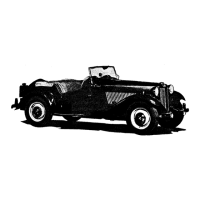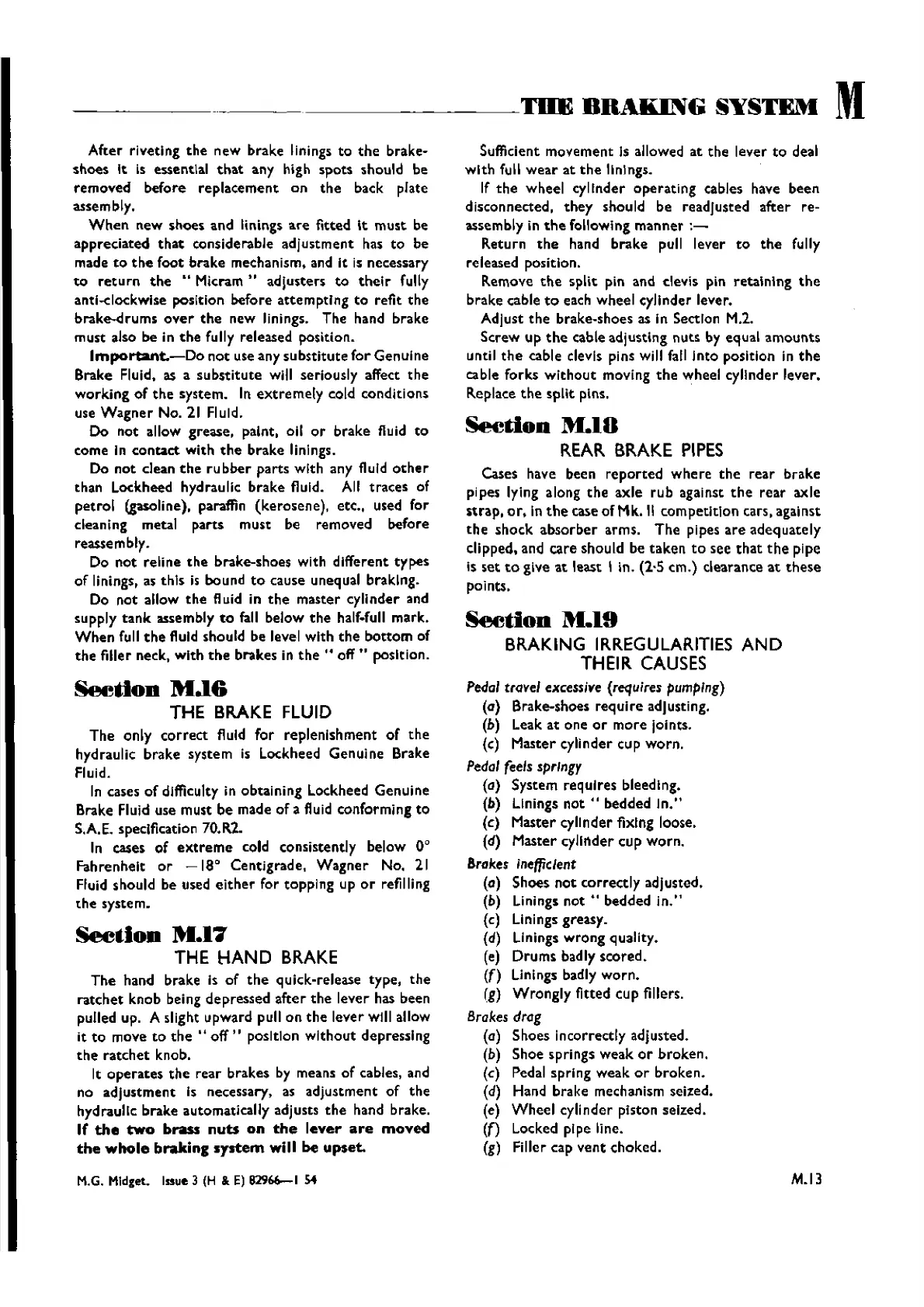---------TIIE
BRAKING
SYSTEM
M
After
riveting
the
new
brake
linings to
the
brake-
shoes
It is essential
enat
any
high
spots
should be
removed
before
replacement
on
the
back plate
assembly.
When
new
shoes
and
linings
are
fitted
It
must
be
appreciated
that
considerable
adjustment
has
to
be
made
to
the
foot
brake
mechanism, and it is necessary
to
return
the
..
Micram"
adjusters
to
their
fully
anti-clockwise position
before
attempting
to
refit
the
brake-drums
over
the
new linings. The hand
brake
must
also be in
the
fully released position.
Important.-Do
not
use any
substitute
for
Genuine
Brake Fluid, as a
substitute
will seriously affect
the
working
of
the
system. In
extremely
cold
conditions
use
Wagner
No.
21
Fluid.
Do
not
allow grease, paint, oil
or
brake
fluid
to
come In
contact
with
the
brake
linings.
Do
not
clean
the
rubber
parts
with
any fluid
other
than Lockheed hydraulic
brake
fluid. All
traces
of
petrol
(gasoline), paraffin
(kerosene),
eec., used for
cleaning
metal
parts
must
be removed before
reassembly.
Do
not
reline
the
brake-shoes
with different
types
of
linings, as
this
is bound
to
cause unequal braking.
Do
not
allow
the
fluid in
the
master
cylinder
and
supply
tank
assembly
to
fall below
the
half-full mark.
When
full
the
fluid should be level
with
the
bottom
of
the
filler neck,
with
the
brakes in
the"
off"
position.
Seedon
M.I6
THE
BRAKE
FLUID
The
only
correct
fluid
for
replenishment
of
the
hydraulic
brake
system is Lockheed
Genuine
Brake
Fluid.
In cases
of
difficulty in
obtaining
Lockheed
Genuine
Brake Fluid use
must
be made
of
a fluid
conforming
to
S.A.E. spectflcatlon 70.R2.
In
eases
of
extreme
cold consistently below 0
0
Fahrenheit
or
_18
0
Centigrade,
Wagner
No.
21
Fluid should be used
either
for
topping
up
or
refilling
the
system.
Seetlon
M.17
THE
HAND
BRAKE
The
hand brake is
of
the
quick-release
type,
the
ratchet
knob
being
depressed
after
the
lever has been
pulled up. A slight
upward
pull on
the
lever will allow
it
to
move
to
the"
off"
position
without
depressing
the
ratchet
knob.
It
operates
the
rear
brakes by means
of
cables, and
no
adjustment
is necessary. as
adjustment
of
the
hydraulic
brake
automatically adjusts
the
hand brake.
If
the
two
brass
nuts
on
the
lever
are
moved
the
whole
braking
system
will be
upset.
M.G. Midget.
Issue
3 (H & E) 82966-1 54
Sufficient
movement
Is allowed
at
the
lever
to
deal
with
full
wear
at
the
linings.
If
the
wheel
cylinder
operating
cables have
been
disconnected.
they
should be
readjusted
after
re-
assembly in
the
following
manner
:-
Return
the
hand
brake
pull lever
to
the
fully
released position.
Remove
the
split
pin and clevis pin
retaining
the
brake
cable
to
each
wheel
cylinder lever.
Adjust
the
brake-shoes as in Section M.2.
Screw
up
the
cable adjusting nuts by equal
amounts
until
the
cable clevis pins will fall Into position in
the
cable forks
without
moving
the
wheel
cylinder
lever.
Replace
the
split
pins.
Seedon
M.IO
REAR
BRAKE
PIPES
Cases have been
reported
where
the
rear
brake
pipes lying along
the
axle
rub
against
the
rear
axle
strap,
or,
in
the
case of Mk. II
competition
cars, against
the
shock
absorber
arms.
The
pipes
are
adequately
clipped, and
care
should be
taken
to
see
that
the
pipe
Is
set
to
give
at
least I in. (l·S
em.)
clearance
at
these
points.
Seetion
RI9
BRAKING
IRREGULARITIES
AND
THEIR
CAUSES
Pedal
travel excessive
(reqUires
pumping)
(a) Brake-shoes
require
adjusting.
(b) Leak
at
one
or
more
[olnts.
(c)
Master
cylinder cup
worn.
Pedal
(eels
springy
(a) System
requires
bleeding.
(b) Linings
not"
bedded
In."
(c)
Master
cylinder fiXing loose.
(d)
Master
cylinder
cup
worn.
Brakes inefficient
(a) Shoes
not
correctly
adjusted.
(b) Linings
not"
bedded
In."
(e)
linings
greasy.
(d) Linings
wrong
quality.
(e)
Drums
badly
scored.
(f)
Linings badly
worn.
(g)
Wrongly
fitted
cup
fillers.
Brakes
drag
(a) Shoes Incorrectly adjusted.
(b)
Shoe
springs
weak
or
broken.
(c) Pedal spring
weak
or
broken.
(d) Hand brake mechanism seized.
(e)
Wheel
cylinder piston seized.
(f)
Locked pipe line.
(g) Filler cap
vent
choked.
M.13
Wishvilles Classic
Automobile Library

